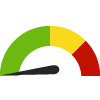Physical Activity and Nutrition Plan Tracker
Hawai‘i can significantly increase physical activity and improve nutrition through collaborative, coordinated efforts of organizations, governments, and individuals working together to implement this updated Physical Activity and Nutrition Plan. Over 200 stakeholders from across the state provided guidance, expertise, and input for this plan. It focuses primarily on policy, systems, and environmental changes that will transform our communities, schools, work places, and health care so the healthy choice will be the easy choice.
The PAN Plan Tracker is funded by the Healthy Hawaii Initiative with support from the Centers for Disease Control and Prevention.
A new PAN Plan Tracker based on the 2030 PAN Plan is under construction. Click here to preview some of the new long term goals.
***This tracker will be retired on December 31, 2023.***
Indicator Gauge Icon Legend
Legend Colors
Red is bad, green is good, blue is not statistically different/neutral.
Compared to Distribution
 the value is in the best half of communities.
the value is in the best half of communities.
 the value is in the 2nd worst quarter of communities.
the value is in the 2nd worst quarter of communities.
 the value is in the worst quarter of communities.
the value is in the worst quarter of communities.
Compared to Target
 meets target;
meets target;  does not meet target.
does not meet target.
Compared to a Single Value
 lower than the comparison value;
lower than the comparison value;
 higher than the comparison value;
higher than the comparison value;
 not statistically different from comparison value.
not statistically different from comparison value.
Trend

 non-significant change over time;
non-significant change over time; 
 significant change over time;
significant change over time;  no change over time.
no change over time.
Compared to Prior Value
 higher than the previous measurement period;
higher than the previous measurement period;
 lower than the previous measurement period;
lower than the previous measurement period;
 no statistically different change from previous measurement period.
no statistically different change from previous measurement period.
State: Hawaii
Physical Activity and Nutrition Long-Term Outcomes
State: Hawaii Adult Fruit and Vegetable Consumption
State: Hawaii Adult Fruit and Vegetable Consumption



State: Hawaii Teen Fruit and Vegetable Consumption
State: Hawaii Teen Fruit and Vegetable Consumption




State: Hawaii Adults with a Usual Source of Health Care
State: Hawaii Adults with a Usual Source of Health Care




State: Hawaii Adults with a Healthy Body Weight
State: Hawaii Adults with a Healthy Body Weight




State: Hawaii Teens with a Healthy Body Weight
State: Hawaii Teens with a Healthy Body Weight




State: Hawaii Adults Who Meet Aerobic Physical Activity Guidelines
State: Hawaii Adults Who Meet Aerobic Physical Activity Guidelines





State: Hawaii Adults Who Meet Muscle Strengthening Guidelines
State: Hawaii Adults Who Meet Muscle Strengthening Guidelines










State: Hawaii Teens Who Meet Aerobic Physical Activity Guidelines
State: Hawaii Teens Who Meet Aerobic Physical Activity Guidelines








State: Hawaii Teens with 2 Hours or Less of TV Time
State: Hawaii Teens with 2 Hours or Less of TV Time




State: Hawaii Young Teens with 2 Hours or Less of TV Time
State: Hawaii Young Teens with 2 Hours or Less of TV Time










State: Hawaii Adults with Health Status of Good or Better
State: Hawaii Adults with Health Status of Good or Better











State: Hawaii Infants Who Were Breastfed at 6 Months
State: Hawaii Infants Who Were Breastfed at 6 Months




State: Hawaii Infants Who Were Breastfed Exclusively Through 3 Months
State: Hawaii Infants Who Were Breastfed Exclusively Through 3 Months




State: Hawaii Infants Who Were Ever Breastfed
State: Hawaii Infants Who Were Ever Breastfed




State: Hawaii Infants Still Breastfeeding at 8 Weeks
State: Hawaii Infants Still Breastfeeding at 8 Weeks




State: Hawaii
Media



State: Hawaii
Community Design and Access - Physical Activity
State: Hawaii Funding for Safe Routes to School
State: Hawaii Funding for Safe Routes to School



State: Hawaii Workers Commuting by Active Transportation
State: Hawaii Workers Commuting by Active Transportation




State: Hawaii Workers Commuting by Bicycling
State: Hawaii Workers Commuting by Bicycling




State: Hawaii Workers Commuting by Public Transportation
State: Hawaii Workers Commuting by Public Transportation





State: Hawaii Workers Commuting by Walking
State: Hawaii Workers Commuting by Walking




State: Hawaii
Community Design and Access - Nutrition
State: Hawaii Farmers Markets that Accept SNAP EBT Transactions
State: Hawaii Farmers Markets that Accept SNAP EBT Transactions


State: Hawaii Statewide Policies that Increase Access to Healthy Food
State: Hawaii Statewide Policies that Increase Access to Healthy Food



State: Hawaii
Educational Systems









State: Hawaii Certified Health and Physical Education Teachers
State: Hawaii Certified Health and Physical Education Teachers



State: Hawaii Positions Supporting School Gardens and Agriculture
State: Hawaii Positions Supporting School Gardens and Agriculture



State: Hawaii Schools with Gardens
State: Hawaii Schools with Gardens



State: Hawaii Schools with Gardens Used for Instruction
State: Hawaii Schools with Gardens Used for Instruction



State: Hawaii Wellness Guidelines for Early Childhood
State: Hawaii Wellness Guidelines for Early Childhood






State: Hawaii Physical Exam Requirement for Grade 7
State: Hawaii Physical Exam Requirement for Grade 7



State: Hawaii
Worksite, Industry, and Business
State: Hawaii Policies Increasing Worksite Wellness Programs
State: Hawaii Policies Increasing Worksite Wellness Programs



State: Hawaii State Worksite Wellness Coordinator
State: Hawaii State Worksite Wellness Coordinator



State: Hawaii
Health Care Systems
State: Hawaii Adult Weight Screening and Follow Up
State: Hawaii Adult Weight Screening and Follow Up




State: Hawaii Children 3-16 Weight Screening and Follow Up
State: Hawaii Children 3-16 Weight Screening and Follow Up




State: Hawaii Doctor Advised About Weight Among Obese/Overweight
State: Hawaii Doctor Advised About Weight Among Obese/Overweight





State: Hawaii Births Occurring in Baby-Friendly Facilities
State: Hawaii Births Occurring in Baby-Friendly Facilities




State: Hawaii Mothers Who Ever Breastfed
State: Hawaii Mothers Who Ever Breastfed




State: Hawaii Infants Who Were Breastfed Exclusively Through 6 Months
State: Hawaii Infants Who Were Breastfed Exclusively Through 6 Months






